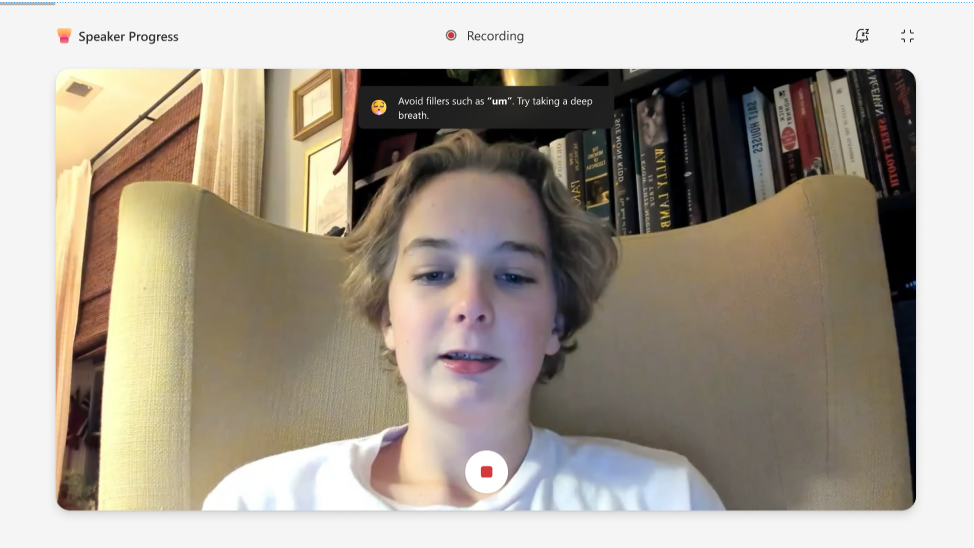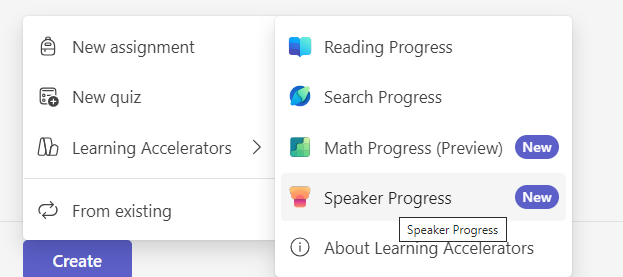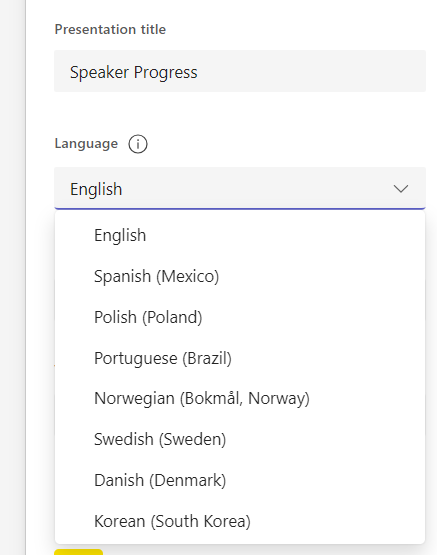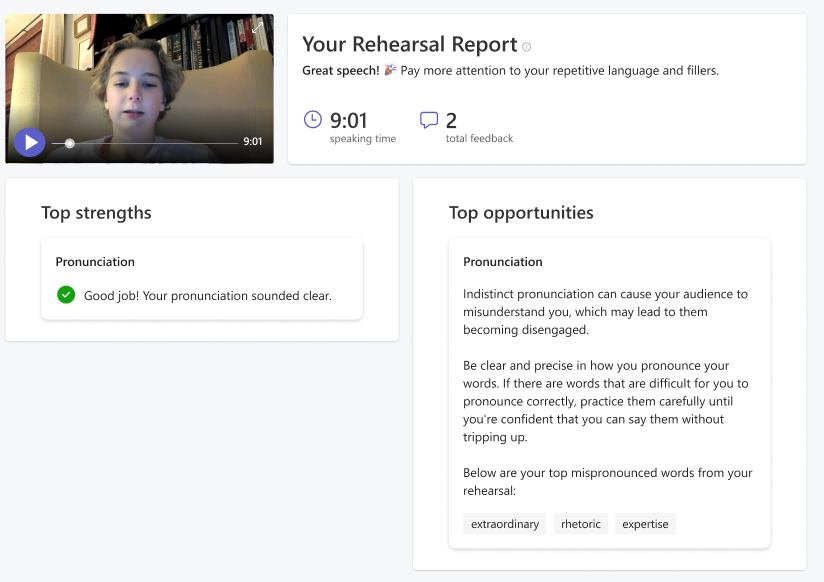Speaker Progress is a feature that can help students and educators alike. It can help students overcome their fear of public speaking and become more confident, captivating, and competent speakers. It can also help educators enhance their teaching methods and outcomes by using a fun and effective tool that supports their students' learning and growth.
Speaker Progress is a useful feature for educators who want to help their students develop their public speaking skills. Educators can use this feature to:
-
Identify common errors: Students can get instant and personalized feedback on their speaking performance. They can learn how to avoid mistakes such as mispronunciation, speaking too fast or slow, relying on filler words, and not making eye contact with the audience.
-
Captivate their audience: Students can learn how to use their voice, tone, and body language to engage their listeners. They can also choose from a variety of topics and genres that interest them and their audience.
-
Boost their confidence: Students can practice speaking with different levels of difficulty and feedback. They can see their progress and achievements as they improve their skills and overcome challenges.
Many people are afraid of public speaking, but Speaker Progress can help students overcome this fear. This new feature teaches students how to read out loud and speak in front of others from an early age.
How to create Speaker Progress assignments
1. Once you create an assignment, you will be able to choose Speaker Progress from the list of Learning Accelerators.
2. You will be able to choose your controls from a side menu on the right.
From this side panel you can set the following:
-
Presentation title: The name of your Speaker Progress presentation.
-
Language: Choose a language for the presentation.
Note: Multi-Language support is available in Speaker Progress for multiple languages including Korean, Danish, Swedish, Spanish, Portuguese, and Norwegian.
-
Number of attempts: Set how many attempts you wish the student to be granted. This is set to "Unlimited" by default.
-
Time limit: Modify the time in which the student's performance will be assessed. The maximum is 10 minutes.
-
AI Feedback: Enable AI feedback to coach students on their speech presentation. This feedback can be set to be Informative, Personal, or Persuasive.
-
Release rehearsal report: Enable or disable student's option to review the rehearsal report before it is graded.
-
Speaker Coach: Use this innovative technology to analyze a student's communication style based upon their delivery, content, and audience engagement.
An AI rehearsal report can provide real time feedback on presentations. This report allows students to review their performance and improve upon their verbal delivery with each attempt.
3. Creator cards will contain information on speed and other content for evaluation.
Recording and PowerPoint sharing in Speaker Progress
Screen sharing is now available for PowerPoint in Speaker Progress. Learners can easily share their presentations with educators and classmates.
This new feature allows educators to seamlessly engage with students' presentations. It fosters a more interactive classroom environment by enabling instant feedback and discussion on presentations. Educators can guide learners through complex concepts directly, enhancing understanding and retention. By integrating recording and PowerPoint sharing, Speaker Progress significantly enhances the educational experience, promoting active learning and engagement.
View your PowerPoint and Speaker Coach notifications, along with your notes.
As an educator, utilizing these tools can significantly enhance your presentations and lectures. PowerPoint allows you to create engaging visual aids that can help illustrate complex concepts and keep students' attention.
Additionally, Speaker Coach provides valuable feedback on speaking habits, such as pace, pitch, and intonation, helping students to improve their delivery and ensure their messages are clear and impactful. With these notifications, learners can stay updated on any changes or suggestions for slides and presentation style, ensuring an effective classroom.
Student experience
How to start a student recording
1. To start recording, choose the My work link to open the attachment.
2. The student will be presented with a screen to check your microphone and video settings before starting.
3. Choose the Start button to start recording.
4. The student begins speaking.
There is a deadline for the recording. A red bar above the recording will show the student that they are running out of time. The session will end automatically when the time is up.
You can decide if you want to retry, see your report, or keep this recording if you're satisfied with the outcome.
What students are evaluated on
Speaker Progress Generative AI evaluates the student on the following:
Body Language: Body language critiques in Speaker Progress provide feedback you can use to better engage with your audience and minimize distractions. The body language critiques have been modified for a stationary, seated position to help you prepare for your visual presentations.
Filler words: When you tell the story to an audience, sounding confident helps make your message persuasive. Filler words such as "um," and "like" are pinpointed by Generative AI and the student is encouraged to avoid these habits.
Pace: Speaker Coach recommends that presenters speak at a rate of 100 to 165 words per minute; this is the rate at which most audiences we've tested find it easiest to process the information they hear. But different people can speak comfortably and clearly at different rates, so your audience may be able to understand you clearly at a different rate. Over time, Speaker Coach will learn from your experience using it.
Pitch: Speaking in monotone can make it harder for the audience to stay engaged or know what to focus on. In order to keep their attention and improve your communication be sure to emphasize the key words and phrases by adjusting your volume and pitch. If you're working from notes or a script be careful not to just read from the script as that can lead you to be more monotone and less natural.
Repetitive language: Repetitive language differs from filler words in that the words or phrases you use repetitively are part of a sentence, rather than things you say to fill the space between sentences.
Speaker Coach uses a database of about 200 common words and phrases. It counts the instances of your use of the words or phrases in that database. If you use them too much, you'll see them called out in the Repetitive Language section of the Your Rehearsal Report window. Some words in the database are checked for whether they occur at the beginning of a sentence. These are words like "basically," "nevertheless," or "technically." Other words are checked for whether they occur at the end of a sentence, such as "right."
Retrying a recording
If the student is not satisfied with your recording, they can choose to retry it by choosing the Retry button. However, the student should be aware that this will erase and replace the existing one. They will not be able to go back and use a previous recording. For example, if they record themselves saying "Hello" and then retry and say "Hi", you will only have the option to submit the "Hi" recording. The "Hello" recording will be gone forever.
The rehearsal report
The report that we have prepared contains a detailed analysis of their recording and some helpful tips on how to enhance their performance in the future. They can use the report to review your strengths and weaknesses, identify areas of improvement, and practice their skills with specific exercises and feedback.
Turning in the assigned recording
After they finish the recording, students can submit it along with your assignment from the same page.
-
Students will submit their recordings by choosing the Turn in button that is located in the top right corner of the page.
-
Once the assigned recording is submitted, the student will receive a confirmation message at the top of the page that says: Turned in at (Time) and (Date). This means that you can review their work and grade it.
Learn more
Speaker Progress in Microsoft Teams for Education - now globally rolled out and generally available



















